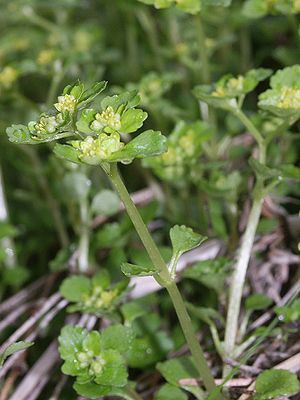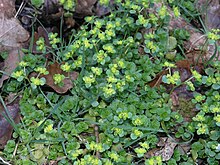Opposite milkweed
| Opposite milkweed | ||||||||||||
|---|---|---|---|---|---|---|---|---|---|---|---|---|

Opposite Milkwort ( Chrysosplenium oppositifolium ) |
||||||||||||
| Systematics | ||||||||||||
|
||||||||||||
| Scientific name | ||||||||||||
| Chrysosplenium oppositifolium | ||||||||||||
| L. |
The Gegenblättrige Chrysosplenium ( Chrysosplenium oppositifolium ) is a plant of the family Saxifragaceae (Saxifragaceae).
description
The Opposite Milkwort is a perennial herbaceous plant that reaches stature heights of five to ten (rarely up to 15) centimeters. In contrast to the alternate milkweed , this species has opposite, hardly notched leaves with a diameter of 10 to 25 mm. The blade of the basal leaves is trimmed at the base and always longer than the petiole. There are no stipules. The plant has a square stem .
A few flowers each sit in a truss- shaped inflorescence with yellow bracts . The flowering period extends from April to May. The very small, hermaphrodite, pre-female, radial symmetry , four-fold, green-yellowish flowers are only about 4 mm in size. There is only one bloom circle, the four sepals are about 2 mm long, the petals are missing. Each flower has eight stamens . The underlying ovary develops from two carpels . There are fruit capsules made with red-brown shiny seeds.
The species has chromosome number 2n = 42.
Occurrence
Opposite Milkwort is common in subatlantic Europe. It is common in Germany, but reaches its limit in the east. In the Alps it is rarely or completely absent, in the Black Forest it reaches altitudes of up to 1,400 meters.
The locations are in forests, in shady, damp places, on the banks of rivers and alder and ash forests adjacent to the stream. Humid to wet, quite nutrient-rich, but lime-poor areas are colonized. The soils are mostly humus, stony or sandy loam, it often occurs on gley soils . It is the character species of the plant community Chrysosplenietum oppositifolii from the association of source corridors of lime-poor locations (Cardamino-Montion), but also occurs in the Carici remotae-Fraxinetum (alder-ash alluvial forests).
ecology
Flies usually act as pollinators. Self-pollination is also not uncommon. The seeds are spread over water, sometimes they are easily thrown away when they come into contact with water droplets. It can reproduce vegetatively via creeping, non-blooming side shoots and forms dense lawns.
Common names
The other common German-speaking names for the opposed milkweed exist or existed : Buttercups ( Silesia ), Eggwort ( Graubünden , Bern ), Goldmilz, Goldveilchen ( Leipzig ), Hoalbletzl ( Tyrol in Pongau and Pinzgau ), Krätzenkraut ( Salzburg ), Krodenkraut ( Werfen , Salzburg, Zillertal ), Krotenkraut ( Carinthia ), Krottenblume ( Lucerne ), Golden Liverwort (Silesia), Gulden Milzkraut ( Alsace ), Rauch Mondkraut (Alsace), Gulden Saxifrage (Alsace), Zittrachkraut (Salzburg), Zittriche (Tyrol) and Zittrichkraut (Tyrol). They are also used identically for the very similar alternate leaf spleen.
swell
- Erich Oberdorfer : Plant-sociological excursion flora . 7th edition. Ulmer, Stuttgart 1994, ISBN 3-8252-1828-7 , pp. 492 .
- Henning Haeupler , Thomas Muer: picture atlas of the fern and flowering plants of Germany (= the fern and flowering plants of Germany. Volume 2). Published by the Federal Agency for Nature Conservation. Ulmer, Stuttgart 2000, ISBN 3-8001-3364-4 , p. 211.
supporting documents
- ↑ Jaakko Jalas, Juha Suominen, Raino Lampinen, Arto Kurtto: Atlas florae europaeae . Volume 12 (Resedaceae to Platanaceae). Page 219, Helsinki 1999. ISBN 951-9108-12-2
- ^ Erich Oberdorfer : Plant-sociological excursion flora for Germany and neighboring areas . 8th edition. Verlag Eugen Ulmer, Stuttgart 2001, ISBN 3-8001-3131-5 . Page 493.
- ^ Georg August Pritzel , Carl Jessen : The German folk names of plants. New contribution to the German linguistic treasure. Philipp Cohen, Hannover 1882, page 97 ( online ).
Web links
- Opposite milkweed. In: FloraWeb.de.
- Opposite milkweed . In: BiolFlor, the database of biological-ecological characteristics of the flora of Germany.
- Profile and distribution map for Bavaria . In: Botanical Information Hub of Bavaria .
- Chrysosplenium oppositifolium L. In: Info Flora , the national data and information center for Swiss flora . Retrieved November 3, 2015.
- Distribution in the northern hemisphere according to: Eric Hultén , Magnus Fries: Atlas of North European vascular plants 1986, ISBN 3-87429-263-0
- Thomas Meyer: Data sheet with identification key and photos at Flora-de: Flora von Deutschland (old name of the website: Flowers in Swabia )
- The virtual floran. Naturhistoriska riksmuseet, accessed March 8, 2009 .

